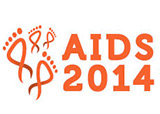 Romidepsin, a cancer drug from the HDAC inhibitor class, awakened HIV-infected immune cells from their latent state, but it did not ultimately shrink the size of the viral reservoir in a small safety and efficacy trial, aidsmap reports. Ole Schmeltz Søgaard, MD, of Aarhus University Hospital in Denmark, presented findings from the Phase I/II clinical trial at the 20th International AIDS Conference (AIDS 2014) in Melbourne, Australia.
Romidepsin, a cancer drug from the HDAC inhibitor class, awakened HIV-infected immune cells from their latent state, but it did not ultimately shrink the size of the viral reservoir in a small safety and efficacy trial, aidsmap reports. Ole Schmeltz Søgaard, MD, of Aarhus University Hospital in Denmark, presented findings from the Phase I/II clinical trial at the 20th International AIDS Conference (AIDS 2014) in Melbourne, Australia.
The trial gave three weekly injections of romidepsin to five men and one woman living with HIV. All of the participants were taking antiretrovirals (ARVs) and had an undetectable viral load at the study’s outset.
There were various indications that romidepsin was succeeding in reversing latency of HIV-infected cells and causing them to begin replicating virus again (this makes them susceptible to ARVs, which cannot combat dormant virus). The drug apparently increased histone H3 acetylation in immune cells, an effect that increased with each dose. This essentially means that the drug was indeed inhibiting enzymes that keep HIV tightly wound within an immune cell’s nucleus. Meanwhile, the levels of cell-associated HIV RNA in CD4s rose in all the participants; each successive dose led to a larger increase. The viral load in plasma also increased, to the level of detectability with a standard viral load test in five of the participants. The composition of CD4 and CD8 cells shifted so that there were more naive cells and fewer effector and central memory cells. Both types of immune cells exhibited reduced expression of a marker signaling cell exhaustion.
However, readings of the total HIV DNA found in the participants’ CD4 cells showed no significant change, suggesting that romidepsin apparently didn’t diminish the size of the viral reservoir.
The drug proved generally safe and well tolerated. The most common side effects were nausea, other gastrointestinal problems and fatigue.
In April 2013, news of Søgaard’s work on HDAC inhibitors led to a frenzy of inaccurate reporting in the popular press claiming that scientists were “within months” of a cure.
To read the aidsmap story, click here.
To read the conference abstract, click here.
Advertisement
Advertisement
Advertisement






Comments
Comments